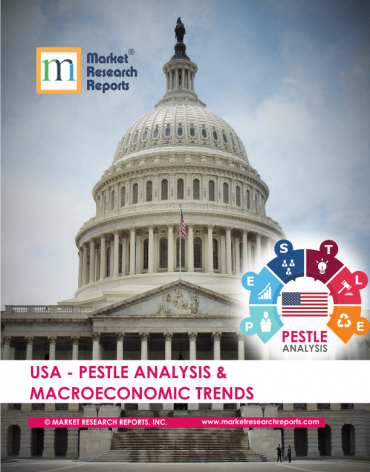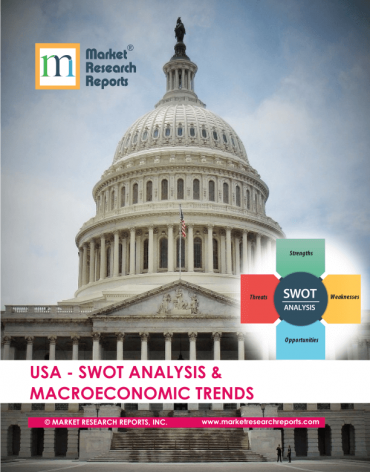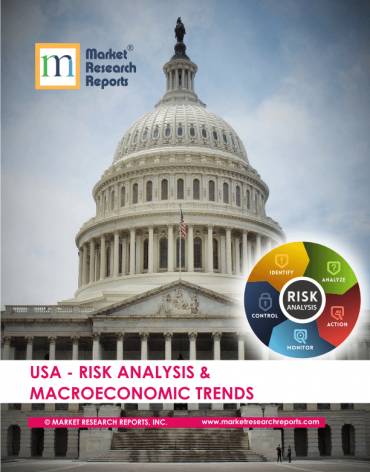Economic Impact of COVID-19 on United States
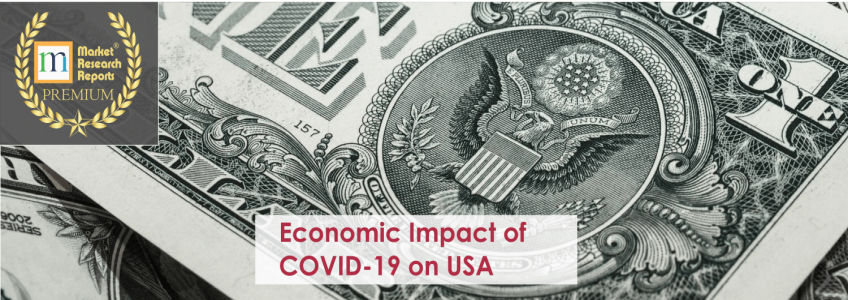
Table of Contents
- 1. Impact of COVID-19 on United States Economy in 2020
- 2. Coronavirus (COVID-19) Containment Measures of United States
- 3. Coronavirus (COVID-19) Fiscal Policy Measures of United States
- 4. Coronavirus (COVID-19) Monetary Policy Measures of United States
- 5. Coronavirus (COVID-19) Employment Policy Measures of United States
- 6. Coronavirus (COVID-19) Social Policy Measures of United States
As United States celebrates its 244th Independence Day today, it not only faces the greatest economic crises but also a humanitarian one. The economy of United States is expected to be adversely affected by ongoing COVID-19 pandemic in 2020. The real gross domestic product (GDP) growth of USA is expected to turn negative, unemployment level to increase and current account balance to decrease due to COVID-19 this year. As of 03rd July 2020, U.S. was still holding number one position in worldwide COVID-19 infections and had 2.86 million confirmed COVID-19 cases out of which around 865,000 people have recovered from the disease while around 132,000 have lost their lives. United States also recorded its highest single day COVID-19 confirmed cases on 03rd July 2020 which stood at 57,209.
In this blog post we will be focusing on economic impact of COVID-19 pandemic on United States. We will also be looking at the containment, fiscal, monetary, employment and social policy measures taken by U.S. government under following sections –
Impact of COVID-19 on United States Economy in 2020
Coronavirus (COVID-19) Containment Measures of United States
Coronavirus (COVID-19) Related Fiscal Policy Measures by United States
Coronavirus (COVID-19) Related Monetary Policy Measures by United States
Coronavirus (COVID-19) Related Employment Policy Measures by United States
Coronavirus (COVID-19) Related Social Policy Measures by United States
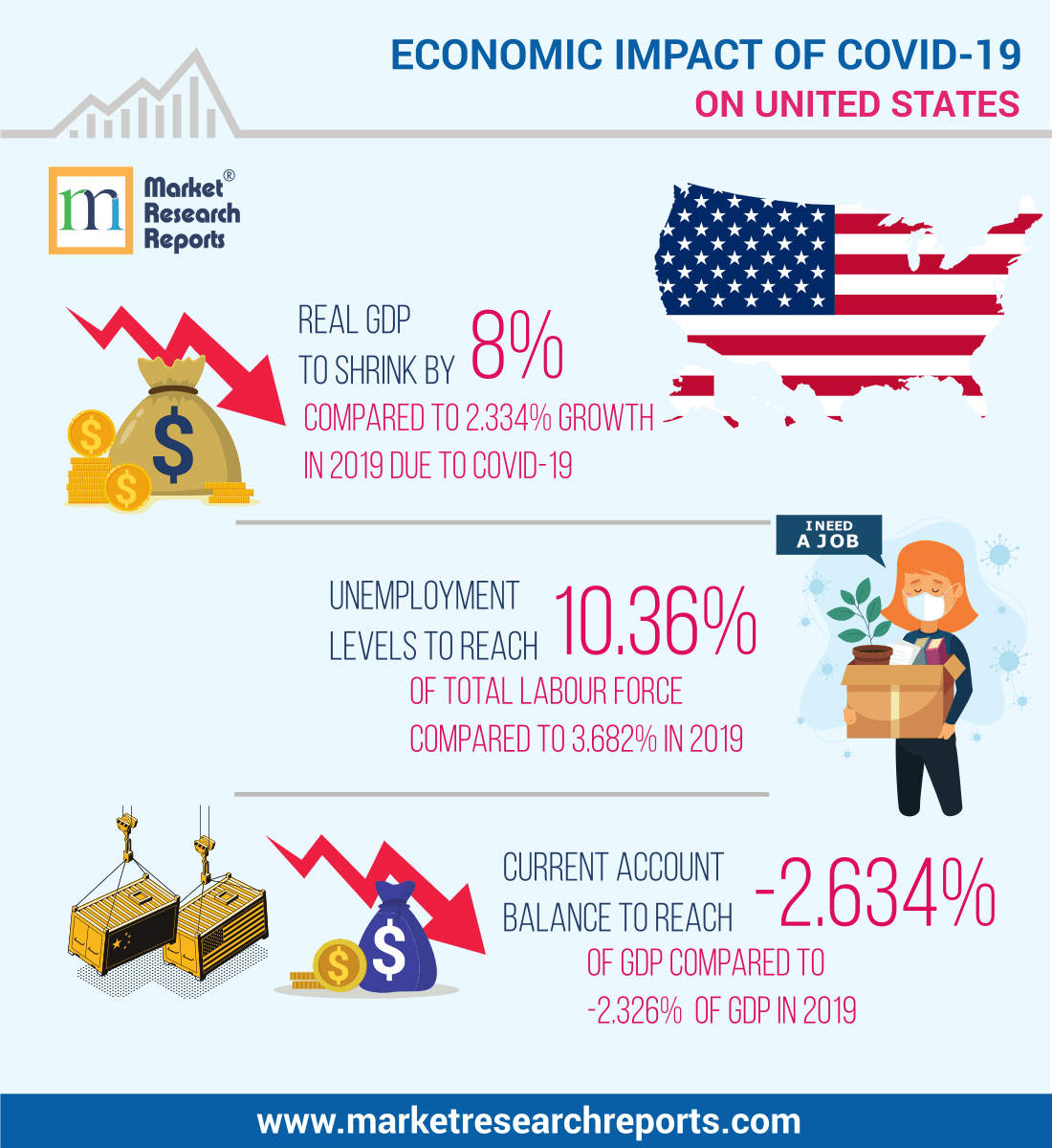
1 . 1. Impact of COVID-19 on United States Economy in 2020
COVID-19 pandemic has severely affected the world’s largest economy. If the COVID-19 outbreak remains growing unabated this can lead to an increased job loss due to curtailed economic activity. United States real GDP is projected to contract by 8% in 2020 compared to 2.334% growth in 2019. This will be the first time after 2009 that the U.S. real GDP growth will turn negative. If United States manages to control the COVID-19 pandemic this year and able to avoid second wave of the virus outbreak the economy can rebound and show real GDP growth of around 4.5% in 2021.
The unemployment rate in United States is expected to increase by 64.46% in 2020 compared to 2019 and reach 10.36% of total labor force.
As per IMF, the current account balance for United States is expected to remain negative at -2.634% of GDP in 2020 compared to -2.326% of GDP in 2019. This implies that United States will remain a net borrower from rest of the world in 2020.
United States government has taken various monetary, fiscal, employment and social policies to lessen the economic impact of COVID-19 pandemic.
2 . 2. Coronavirus (COVID-19) Containment Measures of United States
On 11th March 2020, United States banned entry of all foreign nationals on flights from China, Iran and Europe. On 24th May 2020, all foreign nationals who had been to Brazil,14 days prior to entry in to the United States were banned. School and universities were closed, large scale gatherings were restricted, and restrictions were place on businesses to contain COVID-19 outbreak.
3 . 3. Coronavirus (COVID-19) Fiscal Policy Measures of United States
United States Congress passed an emergency USD 8.3 billion spending bill and a subsequent bill to be worth around USD 108 billion.
The Coronavirus Aid, Relief, and Economic Security (CARES) Act made a provision of USD 2 trillion or 9% of GDP to manage the economic effect of the COVID-19 pandemic in the United States. Under the CARES Act, Businesses of all sizes were to benefit from USD 221 billion in tax reductions and deferrals. This include a 50% of payroll tax credit for severely affected businesses that do not benefit from business interruption loans and agree to maintain employment levels. United States government also deferred payroll tax payments for 2020 to 2021 and 2022. Businesses were also allowed to carry back losses during 2018 to 2020 for next 5 years and were eligible for immediate refunds. The U.S. government also suspended various aviation taxes for the remainder of 2020. As part of the CARES Act, airlines, air cargo, and support firms will receive grants of USD 25 billion, USD 4 billion and USD 3 billion respectively, to maintain employment levels through 30th September 2020.
The Paycheck Protection Program and Health Care Enhancement Act are going to cost additional USD 484 billion (2% of GDP).
United States also announce an emergency package of USD 3 billion for research of a COVID-19 vaccine, over USD 2 billion for prevention & response and USD 1 billion for medical supplies.
The Families First Coronavirus Response Act was brought by United States to support workers and social assistance by providing free testing for the COVID-19, 2 weeks paid sick leave (capped) and then additional paid sick leave for workers with children for up to 3 months. This also covered providing food for households with low income. Money provision was made to support the expected increase of unemployment insurance, which is administered by the states. The bill also increases Medicaid payments to states.
The Small Business Administration (SBA) offered low-interest federal disaster loans for working capital to small businesses suffering from adverse economic effect due to COVID-19 pandemic.
4 . 4. Coronavirus (COVID-19) Monetary Policy Measures of United States
The Federal Open Market Committee (FOMC) lowered interest rates by 100 basis points to 0-0.25%. The Federal Reserve also resumed large scale asset purchases with the purchases of treasury securities and agency mortgage backed securities. The Federal Reserve also announced the intention to revive the programmes from the great financial crisis that will allow it to purchase assets backed by student, car and credit-card loans, as well as loans to businesses through the Small Business Administration (SBA).
The Federal Reserve has introduced a suite of measures to maintain credit flow in the United States economy. This includes increasing liquidity into the reserve purchase market, putting in place funding facilities (for commercial paper, primary dealers and money market mutual funds), actively intervening in bond markets (including municipal bond markets which have been stressed), reducing reserve requirements, relaxing capital buffers and encouraging big banks to use the deposit window.
The Federal Reserve has established temporary dollar liquidity arrangements (swap lines) with several other central banks. These are designed to reduce strains in united states dollar funding markets and thereby ease resulting strains on the supply of credit to households and businesses, both domestically and abroad.
5 . 5. Coronavirus (COVID-19) Employment Policy Measures of United States
United States government encouraged employees to work from home and in flex-hours if possible, to reduce the risk of COVID-19 infections. The CARES Act has provisions to increase the use of short-time compensation (STC). United States federal government will pay 100% of the disbursements for STC for the 26 states that already have the programs implemented. For the rest of the sates, the Federal government will pay 50% if states decide to add a new STC program.
The Small Business Administration (SBA) was instructed to offer low-interest federal disaster loans for working capital to small businesses suffering from adverse economic effect due to COVID-19 pandemic United States Treasury decided to defer tax payments without interest or penalties with the aim of shoring up liquidity. U.S. Senate approved funding of USD 500 billion to support businesses as well as cities and states that have been hard hit by the COVID-19 and USD 350 billion to support lending to small businesses.
6 . 6. Coronavirus (COVID-19) Social Policy Measures of United States
To provide income support to sick workers and their families the United State government brought a new Families First Coronavirus Response Act which made provision to offer 2 weeks of paid sick leave to workers in firms with more than 50 and less than 500 employees. Under the pre-existing Family and Medical Leave Act (FMLA), eligible employees of covered employers were allowed to take up to 12 weeks of unpaid, job-protected leave.
Under the Families First Coronavirus Response Act, compensation of 100% regular rate of pay (up to USD 511 per day) if the employee is sick with COVID-19 or is quarantined/self-isolated following orders from the authorities was made available for full-time/part-time/temporary employees/day laborers. For gig and self-employed were also allowed to avail benefit of the paid leave. They may receive the benefits provided by the EPSLA or EFMLEA in the form of income tax credit (at a level corresponding to the equivalent amounts that employees receive in terms of qualified sick leave / family leave).
To provide income support to quarantined workers who cannot work from home the United States government allowed them to be eligible for paid sick leave as COVID-19 sick workers if the worker
- is subject to a federal, state, or local quarantine or isolation order related to COVID-19
- has been advised by a health care provider to self-quarantine related to COVID-19 or
- is experiencing COVID-19 symptoms and is seeking a medical diagnosis.
Under the Families First Coronavirus Response Act, parents with children under age 18 whose school/childcare facility has closed are entitled to up to 12 weeks paid family leave. The leave is paid at two-thirds of earnings, up to a limit of USD 200 per day and USD 12,000 over the duration. The entitlement covers employees of some public employers and most private employers with fewer than 500 employees. Some employers with fewer than 50 employees can ask for an exemption on business grounds. Workers taking leave are paid by their employers, who can then claim reimbursement from the state through a refundable tax credit. Equivalent credit amounts are available to self-employed individuals under similar circumstances. Workers in some states may have additional entitlements.
To provide income support to persons losing their jobs or self-employment income the United States government increased unemployment insurance, which is administered by the states. The Families First Coronavirus Response Act also increases Medicaid payments to states. Unemployment insurance payments increased by USD 600 per week as well as a direct payment of USD 1200 for each adult and USD 500 for children for all US residents with adjusted gross income up to USD 75,000 (USD 150,000 married). The extra USD 600 payment will last for up to four months. Self-employed people will be newly eligible for unemployment benefits. Max duration for unemployment benefits has been extended to 9 months, including for people already receiving it.
So, what can United States economy and it’s citizens can expect in the remaining 6 months of 2020?
On 30th June 2020, Dr Anthony Fauci told the US Senate that he expects the per day new COVID-19 cases to cross 1,00,000 mark soon. This is certainly not a good sign as it is expected to prolong the economic recovery apart from increasing loss of lives in United States. The message on US dollar say “In God We Trust” but it seems America is “expecting to face the worst” of COVID-19 pandemic yet. We can only hope that by 245th American Independence Day next year the United States is able to recover somewhat both economically and health wise. Amen!
Source - With inputs from Organisation for Economic Co-operation and Development (OECD), International Monetary Fund, World Bank, International Labour Organization (ILO), Government of United States.

